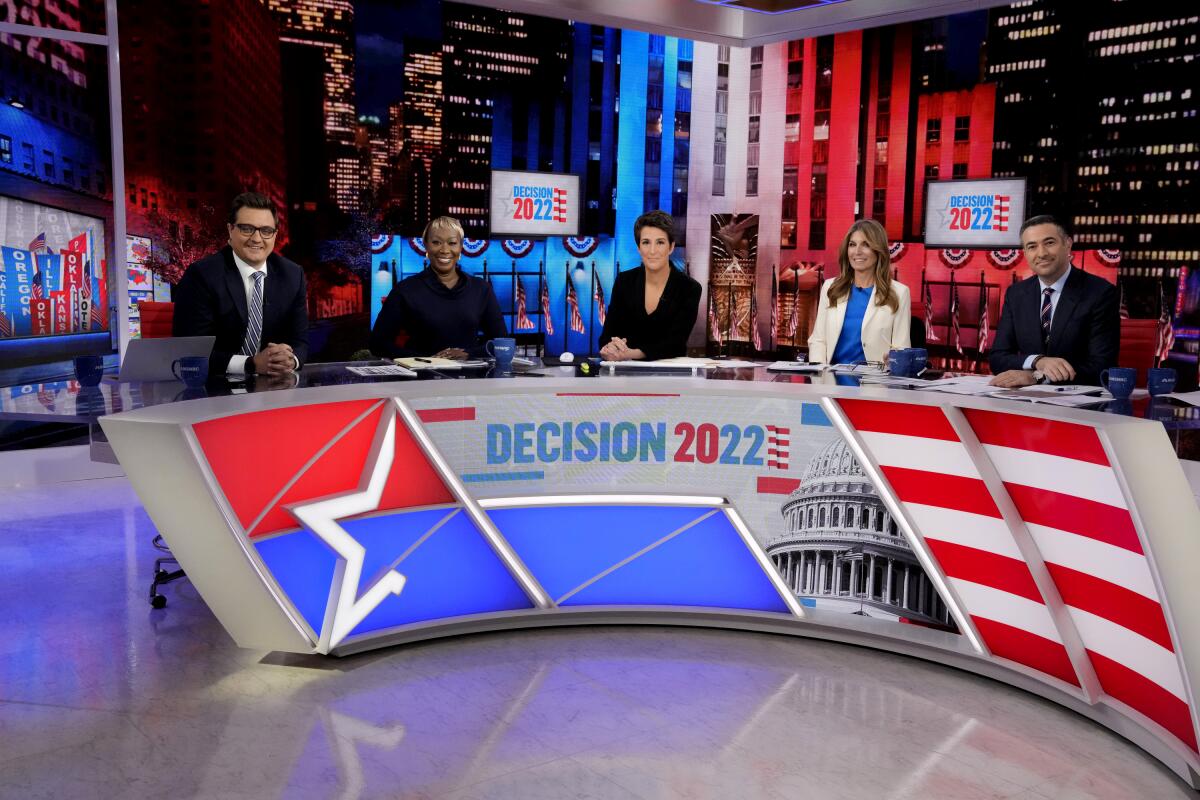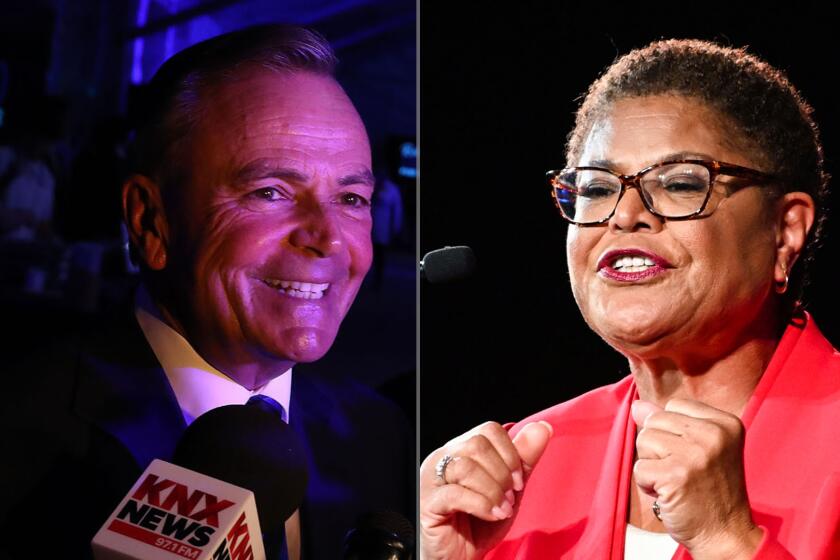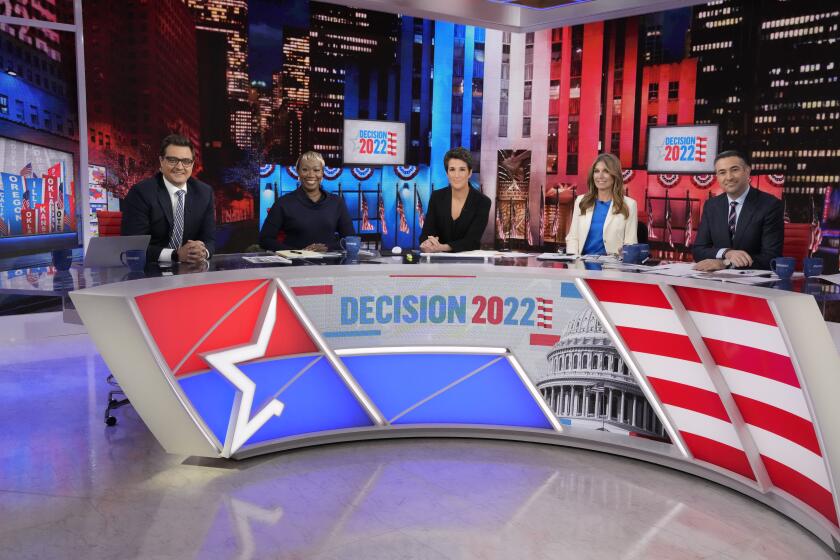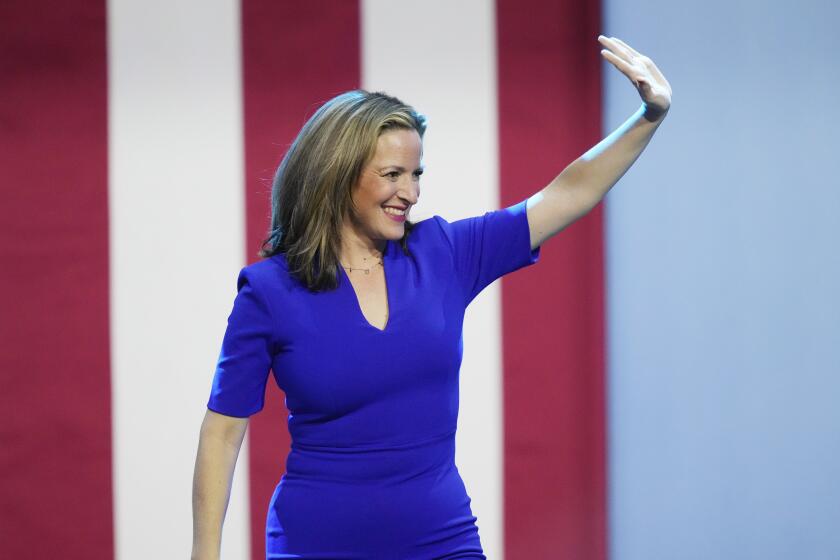Column: The best way to watch election night coverage on TV? Don’t

- Share via
Last night was the first election night in recent memory during which I did not park myself in front of a television for hours to watch “the results.” Consequently, for the first time in years, I have possession of the pertinent facts — no “red wave,” but control of Congress still undecided — without an election night migraine.
I use quotation marks around “the results” because, of course, one cannot spend hours watching election-night results. The actual results can be ascertained in a few minutes once they have finally been tabulated.
What takes hours is the coverage of the tabulation, with all its magic maps, grids, charts and endless predictions and pontificating. About what it would mean if this should happen, or that. About how the polls appear to have been wrong, or right, and why that might be. About what this election might or might not say about President Biden or former President Trump.
Given the deep belief among many that this midterm election, with its likely flipping of Congress to a Republican majority, was a referendum on democracy as we know it, it is not surprising that the broadcast networks modeled the cable news networks with wall-to-wall election night coverage.
Of which I watched exactly none.
There is an upside to the frenzy. It is thrilling to see midterm elections being treated as seriously as presidential elections, to know that people — especially young people — understand the importance of all levels of government. But after the last two presidential elections, I couldn’t face coverage that is essentially based on anxiety.
I checked in on those races that had been called before midnight on Tuesday and again when I awoke on Wednesday, but not on television. Or, for that matter, on Twitter. Like many Americans, I have deep hopes and fears for this election, but I was not seeking real-time chagrin, or glee, or outrage or educated guesswork.
I just wanted to know the actual results, some of which would not be clear on Tuesday night or even Wednesday. I looked at The Times, but any digital news platform would have done. I would rather seek analysis than have it noisily thrust upon me.
We pay tribute to the media figures we’ve relied on during a strange, tense week in American politics, from podcasters to local newspaper reporters.
Call it cowardice, but I simply could not face the sight and sound of all those former political operatives, media figures and academics hauled into the various studios or Zoom rooms to provide endless commentary as if election night was a football game or the Olympics and not, you know, election night. Which everyone knew would not immediately produce winners in all the races.
For the record, I am not a big fan of football or most Olympics commentary either. But at least in those cases, there is something to comment upon, an actual live event in which the activity is as — if not more — interesting than the outcome. And in which there is always a same-day outcome.
The collective act of voting is newsworthy — the trouble or ease of doing it, the motivations of those who attempt to make it simpler or more difficult, the dedication of those who endure inclement weather or long lines to participate in democracy, the experience of the poll workers.
This year, several states were operating under new laws controlling who can and cannot vote; that was definitely something worth paying attention to in real time.
Rick Caruso edges slightly ahead of Rep. Karen Bass in the race to become the 43rd mayor of Los Angeles. But the race is still too close to call.
As of now, there have been few reports of major problems, though investigations into any complaints will take time.
On election night, however, the action — counting votes — is not shown on television and is therefore fully replaced for hours by commentary, which is not only useless but increasingly dangerous. Predictions are often wrong, and opinions about politics are often seen as (and quite often are) political opinions.
All of which increases the public’s belief that the media is inaccurate and partisan.
This is not a criticism of anyone who appeared on any television news outlet Tuesday night — they were simply doing their jobs as demanded by their networks. For years, I, like millions of Americans, delighted in the maps and graphics, the deep-drilling county-by-county analysis. On presidential election nights, it illuminated the workings of the electoral college; during midterms, it makes real the significance of redistricting.
Fox News scored the most viewers on election night, but all the networks were down from 2018 as traditional TV viewing declines.
But given the current narrative about the state of the union — deeply divided doesn’t even begin to describe it — I’m not sure those maps (which even non-TV news platforms including The Times use) are helping much. Once easy shorthand for the parties of each state’s victors, they now seem to reduce our very complicated country into blocks of blue and red, which only amplifies the us-versus-them mentality that has so many people wondering what a modern civil war would look like.
As for all the prognosticating, well, if Hillary Clinton’s loss after a year of pundits assuming her victory didn’t teach us the perils of polls and predictions, I don’t know what will.
The problem, as usual, is us. It’s a matter of supply and demand. Over the years, election nights have become a ratings bonanza for news networks, which have increasingly festooned their coverage with eye-catching graphic embellishments and movie-score-quality music.
This is the magic of television, of course, but it seems important to remember that the inevitable hours-long rehash of pre-election-day prognostication and graphics-aided scenarios is not so much about reporting as it is about emotional engagement. Like the replay of a cliff-hanger to increase interest in its resolution.
Which is fine if you want to keep audiences in a twist over whether some character survived a zombie attack but not so great when it involves the country’s governance.
If people feel moved to celebrate, or obliged to take to the streets, it would be nice if they knew what actually happened first.
“With 13% of precincts reporting” results is not valuable information. At best, it makes viewers believe they are involved in some sort of “play at home” game; at worst, it allows people to see corruption when a lead is overturned.
Republicans who backed Trump’s efforts to overturn the 2020 election lose key races for positions in which they would have overseen elections. But in some areas, they’re poised to win.
Any election has been won or lost the moment the polls close. The rest is just waiting. What will happen has already happened, so keep your 13% results to yourself and call me when you know what happened.
There will be plenty of time for worry, triumph, outrage and pontificating after that. All of which will be much more reasonable and easier to process without an election night hangover.
More to Read
The biggest entertainment stories
Get our big stories about Hollywood, film, television, music, arts, culture and more right in your inbox as soon as they publish.
You may occasionally receive promotional content from the Los Angeles Times.














